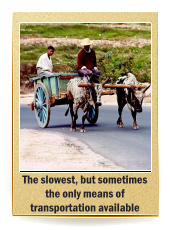Practical information
There is no Malagasy embassy in Poland and vice versa – no Polish embassy in Madagascar.
Costs:
Visa bought at the airport in Antananarivo: 26 USD
Airplane ticket: ca. 1200 USD
You should set aside 15-20 USD per each day of the trip, of which 10 USD will be sufficient to cover the cost of food and hotel accommodation.
Departure tax (when leaving Madagascar): ca. 23 USD
Health:
Hepatitis A and B vaccination is recommended. It is also necessary to take anti malaria drugs, such as Arechin or Nivaqine (Lariam may be ineffective). Drink a lot of water (mineral water is available almost everywhere), eat meat only if properly cooked or fried. Use salt in abundance, supply increased amounts of vitamins and minerals.
Risks:
Pay special attention to your belongings. Keep your money in a waist or neck wallet. Beware of pickpockets, especially in the cities, and don’t take lonely walks after dark. Avoid showing off with your brand-name camera or camcorder.
Useful equipment:
Small padlock, earplugs, body cream with UV-filter, head torch
Official languages:
Malagasy and French.
Currency:
1 ariary - in the text below the previous currency may occasionally be referred to, namely the Malagasy franc (MGF). Even though officially replaced in 2005, the franc is still in circulation, especially in distant corners of the island. Quite interestingly, 1 ariary is divided into 5 iraimbilanja. Its conversion rate to the franc is 1:5.
Price examples: hotel 4-10 USD; lunch 0.6-50 USD; bread (wheat baguette) 0.20 USD; mineral water 0.6-1 USD; entrance fee to the national park 10 USD; hiring a guide 5-12 USD; phone call to Europe 3.50 USD/min.
Optimum time for visiting:
from August to October
Climate:
The rainy season lasts from December to April; tropical wet climate is characteristic of the eastern and northern regions of the island, whereas the south has a tropical dry climate.
Internal transportation:
Air-Mad airplanes cover a broad range of destinations in Madagascar. Plane tickets are inexpensive. Moreover, if you fly with Air-Mad to the island, you can count on a 50% discount on domestic flights.
 Buses are practically non-existent, but there are cheap mini-buses instead, or even cheaper "taxi-brousse", i.e. pick-ups packed full with people and luggage. The slowest, but sometimes the only means of transportation available
Buses are practically non-existent, but there are cheap mini-buses instead, or even cheaper "taxi-brousse", i.e. pick-ups packed full with people and luggage. The slowest, but sometimes the only means of transportation available
Accommodation:
Almost every large village situated near a main road has a cheap, basic standard hotel. Hotels in the cities usually offer a slightly higher standard (with electricity, shower, etc). In remote locations, far from civilization (i.e. from the road), you can find a place to sleep in after obtaining a permission from the village head. Sometimes a tent comes in handy.
Food:
Not a problem at all. There are shops in villages, where you can buy French bread and mineral water (or at least soap, rice, Coke and beer).
 In large villages and towns there are "hotels", i.e. bars serving hot meals, for example rice with meat.
In large villages and towns there are "hotels", i.e. bars serving hot meals, for example rice with meat.
Guidebooks and maps:
Lonely Planet’s "Madagascar and Comoros" is a first-class guidebook, but the prices quoted therein are lower than actual ones (apart from Air-Mad ticket prices). The map of Madagascar (scale 1:2000000) published by Ravenstein Verlag GmbH will suffice. More detailed maps, though usually out-of-date, can be purchased in Antananarivo.



